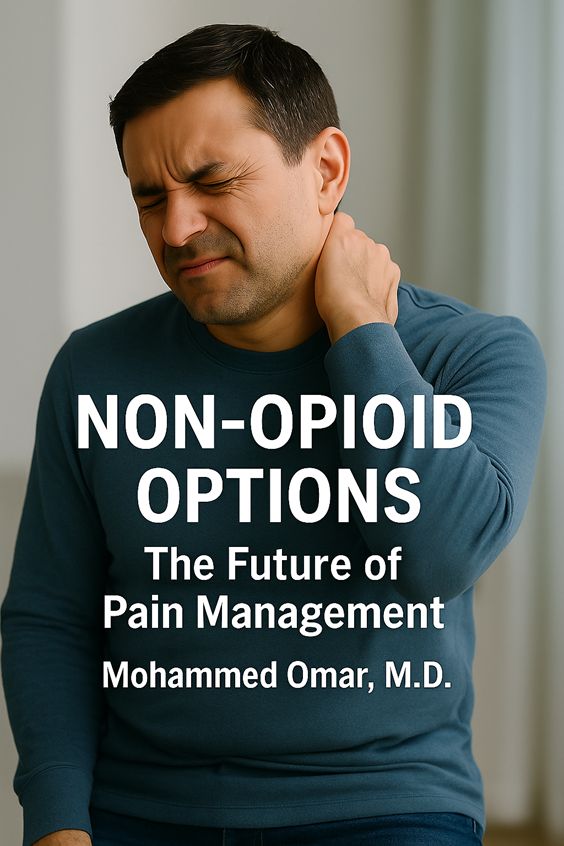Non-Opioid Options – The Future of Pain Management (2025 Update)

Pain is a persistent challenge for many people, making everyday tasks harder and reducing quality of life. At West Florida Pain, we specialize in diagnosing and treating painful conditions with a focus on your particular needs, preferences and overall health. Today, there are more advanced, non-opioid pathways to help relieve or reduce pain, aligned with 2025 legal and regulatory frameworks.
A Personalized, Multimodal Approach
Effective pain management now emphasizes a multimodal, individualized strategy. According to the Centers for Disease Control and Prevention (CDC), non-pharmacologic therapies (such as exercise, physical therapy, psychological approaches) and non-opioid pharmacologic options (such as NSAIDs, certain SNRIs, gabapentinoids for neuropathic pain) should be maximized as appropriate for the patient’s situation. CDC+1 Opioids are reserved only after other approaches have been tried and when the expected benefits outweigh risks. AAFP+1
At our practice, we work with you to:
- Assess and document your pain sources and types
- Set functional & quality-of-life goals rather than expecting “zero pain”
- Use shared decision-making to choose treatments that align with your values
- Monitor and adjust treatments over time, focusing on pain and function
Non-Opioid Medication Options
Many non-opioid medications are now recognized and used more broadly. For example, for conditions such as osteoarthritis, neuropathic pain or fibromyalgia, guideline-supported medications include:
- Topical or oral non-steroidal anti-inflammatory drugs (NSAIDs)
- Selective serotonin–norepinephrine reuptake inhibitors (SNRIs)
- Gabapentinoids (for neuropathic pain)
AAFP
Additionally, the Food & Drug Administration (FDA) approved a novel non-opioid analgesic in January 2025 (e.g., Suzetrigine, marketed as “Journavx”), which is the first new class of non-opioid pain medication in decades and reflects the evolving landscape of non-opioid pharmacotherapy. Wikipedia+2The Lancet+2
These developments underscore that pharmacologic options are expanding — but they still work best when combined with other therapies, and when used cautiously, with monitoring.
Non-Pharmacologic & Interventional Therapies
In addition to medications, a variety of non-drug and minimally invasive interventions play a central role in modern pain management. These include:
- Physical therapy, exercise, stretching and function-restoring movement
- Behavioral therapies: cognitive behavioral therapy (CBT), biofeedback, stress management
- Minimally invasive interventional treatments: nerve blocks, nerve stimulation (e.g., spinal cord stimulators), targeted injections
- Neuromodulation and other device-based therapies
Guidelines from the American Academy of Pain Medicine (AAPM) emphasize that these interventions can be appropriate when part of a coordinated multidisciplinary plan. AAPM
At our clinic, we tailor a plan that may include one or more of these therapies depending on your pain type, medical history, goals and risk profile.
Regulatory & Reimbursement Changes in 2025
Important legal and regulatory changes now shape how non-opioid options are supported and reimbursed:
- The Non‑Opioids Prevent Addiction in the Nation Act (NOPAIN Act), effective January 1, 2025, directs the Centers for Medicare & Medicaid Services (CMS) to provide separate reimbursement for qualifying non-opioid pain treatments in hospital outpatient and ambulatory surgery settings — meaning providers can offer non-opioid options without them being bundled into traditional procedure payments. AAHKS | Educate. Advocate. Investigate.+1
- On September 10 2025 the FDA issued a draft guidance document titled “Development of Non-Opioid Analgesics for Chronic Pain”, detailing how new non-opioid drugs should be developed — signalling a regulatory push toward broader non-opioid treatment availability. Federal Register+1
These changes improve access to non-opioid options and reflect a national policy shift away from default opioid prescribing.
Emerging & Advanced Therapies
We also offer some newer and advanced options where appropriate (subject to individual assessment):
- Ketamine infusions: Although careful assessment is required, ketamine (administered in controlled medical settings) can reset certain brain/spinal cord neurotransmitter pathways and may reduce reliance on opioids for some patients.
- Stem cell or biologic injections: In select cases, when other treatments have been exhausted and after informed consent, biologic therapies aimed at reducing inflammation and promoting regenerative responses may be considered. These are used conservatively given evolving evidence.
- Neuromodulation and implantable stimulator devices: For patients with refractory chronic pain, device-based therapies may offer relief when traditional approaches are insufficient.
What This Means for You
Whatever treatment path we choose, the guiding principle is informed choice, safety, and long-term function. Here’s what you should expect:
- We will explore non-opioid options first — both non-drug and drug therapies — before considering opioid medications (unless your situation clearly calls for them).
- You’ll be part of the decision-making process: we’ll discuss the risks and benefits of each option, including non-opioid and opioid treatments.
- We aim to improve your ability to function — not necessarily eliminate all pain — though pain reduction is still a key goal.
- If you have been on opioids or are at risk of dependence, we will coordinate care with behavioral health specialists for support with withdrawal, coping strategies, and psychological therapy as needed.
- We’ll monitor your progress, adjust therapies, and coordinate multidisciplinary care so you receive the most appropriate combination of treatments.
In Summary
Pain doesn’t have to mean a life of limitation or dependency. With the 2025 enhancements in law, guideline science, and therapeutic options, you now have more choices than ever. By taking a comprehensive, patient-centered approach that emphasizes non-opioid modalities first, we can work together to restore your active life while minimizing risks.
If you’re ready to actively engage in your pain management plan — to understand your options, set realistic goals, and choose the treatment mix that fits your life — we’re here to help.
